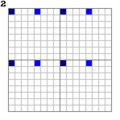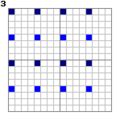| Revision as of 20:07, 29 June 2006 editMysid (talk | contribs)Extended confirmed users13,497 editsm correcting typo for better readablity← Previous edit | Latest revision as of 07:09, 18 February 2024 edit undoAnomieBOT (talk | contribs)Bots6,567,178 editsm Dating maintenance tags: {{Why}} | ||
| (55 intermediate revisions by 40 users not shown) | |||
| Line 1: | Line 1: | ||
| {{Short description|Interlacing algorithm for raster images}} | |||
| ⚫ | |||
| {{About|the interlacing scheme for images|the gene|ADAM7}} | |||
| ] | |||
| ] | |||
| ⚫ | '''Adam7''' is an ] ] for ]s, best known as the interlacing scheme optionally used in ] images. An Adam7 interlaced image is broken into seven subimages, which are defined by replicating this 8×8 pattern across the full image. | ||
| ⚫ | {| style="margin: 1em auto; background: transparent;" | ||
| | | |||
| <pre>1 6 4 6 2 6 4 6 | <pre>1 6 4 6 2 6 4 6 | ||
| 7 7 7 7 7 7 7 7 | 7 7 7 7 7 7 7 7 | ||
| Line 9: | Line 17: | ||
| 7 7 7 7 7 7 7 7 | 7 7 7 7 7 7 7 7 | ||
| </pre> | </pre> | ||
| |} | |||
| </table> | |||
| ⚫ | '''Adam7''' is |
||
| The subimages are then stored in the image file in numerical order. | |||
| Adam7 is a two-dimensional interlacing scheme, unlike the one-dimensional scheme used in an interlaced ]. This means the perceived quality of the image and the readability of text in the image rises much faster in the early passes than with GIF interlacing. | |||
| Adam7 uses seven passes and operates in both dimensions, compared to only four passes in the vertical dimension used by ]. This means that an approximation of the entire image can be perceived much more quickly in the early passes, particularly if interpolation algorithms such as ] are used.<ref></ref> | |||
| ==Summary== | |||
| ⚫ | == History == | ||
| * Two-dimensional interlacing scheme | |||
| ⚫ | Adam7 is named after Adam M. Costello, who suggested the method on February 2, 1995, and after the seven steps involved. | ||
| * PNG first interlace pass displays 1/64th of the image data | |||
| * The GIF format on the other hand displays 1/8th of the image data | |||
| * PNG will send 4 passes to GIF's 1st pass | |||
| It is a rearrangement<ref>{{cite mailing list |title= interlacing revisited: the Adam7 scheme |date= 2 Feb 1995 |accessdate=2016-04-18 |mailing-list= png-list |last= Costello |first= Adam M. |quote= I rearranged the Lee7 scheme a bit (Lee7 is the obvious extension to Lee's 5-pass scheme), coming up with the Adam7 scheme |url= http://pmt.sourceforge.net/mailing-lists/png-list/png-list.199502.gz }}</ref> of this five-pass scheme<ref>{{cite mailing list |title= Interlace methods: visual testing |date= 1 Feb 1995 |accessdate=2016-04-18 |mailing-list= png-list |last= Lane |first= Tom |quote= Lee Crocker's 5-pass 2-D interlace proposal |url= http://pmt.sourceforge.net/mailing-lists/png-list/png-list.199502.gz }}</ref> that had earlier been proposed by ]: | |||
| ⚫ | ==History== | ||
| {| style="margin: 1em auto; background: transparent;" | |||
| |----- | |||
| | | |||
| <pre>1 5 3 5 | |||
| 5 4 5 4 | |||
| 3 5 2 5 | |||
| 5 4 5 4 | |||
| </pre> | |||
| |} | |||
| Alternative speculative proposals at the time included square spiral interlacing and using ]s, but these were rejected as being overcomplicated. | |||
| == Passes == | |||
| The pixels included in each pass, and the total pixels encoded at that point are as follows: | |||
| <gallery> | |||
| File:Adam7_pass_1.png|Pass 1, 1/64 = 1.5625% | |||
| File:Adam7_pass_2.png|Pass 2, 1/32 = 3.125% | |||
| File:Adam7_pass_3.png|Pass 3, 1/16 = 6.25% | |||
| File:Adam7_pass_4.png|Pass 4, 1/8 = 12.5% | |||
| File:Adam7_pass_5.png|Pass 5, 1/4 = 25% | |||
| File:Adam7_pass_6.png|Pass 6, 1/2 = 50% | |||
| File:Adam7_pass_7.png|Pass 7, 1/1 = 100% | |||
| </gallery> | |||
| When rendering, the image will generally be interpolated at earlier stages, rather than just these pixels being rendered. | |||
| ⚫ | == Related algorithms == | ||
| Adam7 is a multiscale model of the data, similar to a ] with ]s, though it starts from an 8×8 block, and ]s the image, rather than ] (]ing, then downsampling). It thus offers worse frequency behavior, showing artifacts (]) at the early stages, in return for simpler implementation. | |||
| === Iteration === | |||
| Adam7 arises from iteration of the following pattern: | |||
| {| style="margin: 1em auto; background: transparent;" | |||
| |----- | |||
| | | |||
| <pre>12 | |||
| 33 | |||
| </pre> | |||
| |} | |||
| which may be interpreted as "folding" in the vertical and horizontal dimensions. Similarly, GIF interlacing {{samp|1324}} can be seen as iteration of the {{samp|12}} pattern, but only in the vertical direction ({{samp|12}} expands to {{samp|1.2.}} which is filled in as {{samp|1324}}). | |||
| Using this 3-pass pattern means the first pass is (1/2)<sup>2</sup> = 1/4 (25%) of the image. | |||
| Iterating this pattern once yields a 5-pass scheme; after 3 passes this yields | |||
| {| style="margin: 1em auto; background: transparent;" | |||
| |----- | |||
| | | |||
| <pre>1 . 2 . | |||
| . . . . | |||
| 3 . 3 . | |||
| . . . . | |||
| </pre> | |||
| |} | |||
| which is then filled in to: | |||
| {| style="margin: 1em auto; background: transparent;" | |||
| |----- | |||
| | | |||
| <pre>1 4 2 4 | <pre>1 4 2 4 | ||
| 5 5 5 5 | 5 5 5 5 | ||
| 3 4 3 4 | 3 4 3 4 | ||
| 5 5 5 5 | 5 5 5 5 | ||
| </pre |
</pre> | ||
| |} | |||
| ⚫ | Adam7 is named after Adam M. Costello, who suggested the method on |
||
| In the 5-pass pattern, the first pass (1/4)<sup>2</sup> = 1/16 (6.25%) of the image. | |||
| Iterating again yields the 7-pass Adam7 scheme, where the first pass (1/8)<sup>2</sup> = 1/64 (1.5625%) of the image. | |||
| In principle this can be iterated, yielding a 9-pass scheme, an 11-pass scheme, and so forth, or alternatively an adaptive number of passes can be used, as many as the image size will allow (so the first pass consists of a single pixel), as is usual in scale-free multiscale modeling. In the context that PNG was developed (i.e., for the image sizes and connection speeds in question), a 7-pass scheme was seen as sufficient,{{why|date=February 2024}} and preferable to a simple 5-pass scheme. | |||
| == References == | |||
| {{compu-graphics-stub}} | |||
| {{Reflist}} | |||
| ==External links== | |||
| ⚫ | |||
| * | |||
| ] | |||
| ] | |||
| ] | |||
Latest revision as of 07:09, 18 February 2024
Interlacing algorithm for raster images This article is about the interlacing scheme for images. For the gene, see ADAM7.

Adam7 is an interlacing algorithm for raster images, best known as the interlacing scheme optionally used in PNG images. An Adam7 interlaced image is broken into seven subimages, which are defined by replicating this 8×8 pattern across the full image.
1 6 4 6 2 6 4 6 7 7 7 7 7 7 7 7 5 6 5 6 5 6 5 6 7 7 7 7 7 7 7 7 3 6 4 6 3 6 4 6 7 7 7 7 7 7 7 7 5 6 5 6 5 6 5 6 7 7 7 7 7 7 7 7 |
The subimages are then stored in the image file in numerical order.
Adam7 uses seven passes and operates in both dimensions, compared to only four passes in the vertical dimension used by GIF. This means that an approximation of the entire image can be perceived much more quickly in the early passes, particularly if interpolation algorithms such as bicubic interpolation are used.
History
Adam7 is named after Adam M. Costello, who suggested the method on February 2, 1995, and after the seven steps involved.
It is a rearrangement of this five-pass scheme that had earlier been proposed by Lee Daniel Crocker:
1 5 3 5 5 4 5 4 3 5 2 5 5 4 5 4 |
Alternative speculative proposals at the time included square spiral interlacing and using Peano curves, but these were rejected as being overcomplicated.
Passes
The pixels included in each pass, and the total pixels encoded at that point are as follows:
-
 Pass 1, 1/64 = 1.5625%
Pass 1, 1/64 = 1.5625%
-
 Pass 2, 1/32 = 3.125%
Pass 2, 1/32 = 3.125%
-
 Pass 3, 1/16 = 6.25%
Pass 3, 1/16 = 6.25%
-
 Pass 4, 1/8 = 12.5%
Pass 4, 1/8 = 12.5%
-
 Pass 5, 1/4 = 25%
Pass 5, 1/4 = 25%
-
 Pass 6, 1/2 = 50%
Pass 6, 1/2 = 50%
-
 Pass 7, 1/1 = 100%
Pass 7, 1/1 = 100%
When rendering, the image will generally be interpolated at earlier stages, rather than just these pixels being rendered.
Related algorithms
Adam7 is a multiscale model of the data, similar to a discrete wavelet transform with Haar wavelets, though it starts from an 8×8 block, and downsamples the image, rather than decimating (low-pass filtering, then downsampling). It thus offers worse frequency behavior, showing artifacts (pixelation) at the early stages, in return for simpler implementation.
Iteration
Adam7 arises from iteration of the following pattern:
12 33 |
which may be interpreted as "folding" in the vertical and horizontal dimensions. Similarly, GIF interlacing 1324 can be seen as iteration of the 12 pattern, but only in the vertical direction (12 expands to 1.2. which is filled in as 1324).
Using this 3-pass pattern means the first pass is (1/2) = 1/4 (25%) of the image.
Iterating this pattern once yields a 5-pass scheme; after 3 passes this yields
1 . 2 . . . . . 3 . 3 . . . . . |
which is then filled in to:
1 4 2 4 5 5 5 5 3 4 3 4 5 5 5 5 |
In the 5-pass pattern, the first pass (1/4) = 1/16 (6.25%) of the image.
Iterating again yields the 7-pass Adam7 scheme, where the first pass (1/8) = 1/64 (1.5625%) of the image.
In principle this can be iterated, yielding a 9-pass scheme, an 11-pass scheme, and so forth, or alternatively an adaptive number of passes can be used, as many as the image size will allow (so the first pass consists of a single pixel), as is usual in scale-free multiscale modeling. In the context that PNG was developed (i.e., for the image sizes and connection speeds in question), a 7-pass scheme was seen as sufficient, and preferable to a simple 5-pass scheme.
References
- Introduction to PNG - nuwen.net
- Costello, Adam M. (2 Feb 1995). "interlacing revisited: the Adam7 scheme". png-list (Mailing list). Retrieved 2016-04-18.
I rearranged the Lee7 scheme a bit (Lee7 is the obvious extension to Lee's 5-pass scheme), coming up with the Adam7 scheme
- Lane, Tom (1 Feb 1995). "Interlace methods: visual testing". png-list (Mailing list). Retrieved 2016-04-18.
Lee Crocker's 5-pass 2-D interlace proposal